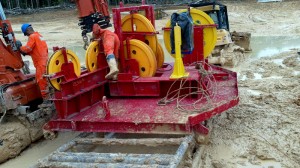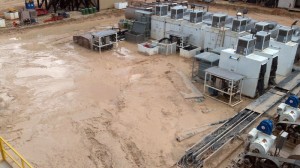SEDS rig nears finish on Brazilian Solimões exploratory well

HRT Oil & Gas is close to completing the exploratory phase of the first 3,000-meter well in Brazil’s remote Solimões Basin using a self-erecting drilling system (SEDS) rig manufactured by Integrated Drilling Equipment (IDE). The rig, purchased by Tuscany International Drilling of Calgary, is one of two deployed to the region via helicopter earlier this year. Drilling on the second exploratory well began in early August. The compact rigs’ design comes from the offshore modular rig, with features that include state-of-the-art VFD electronics and controls, a special hydraulics package for lifting sub and lightweight mud pumps and drawworks.
Among the operational challenges in the region are the roughly 1,000 meters of hard basalt rock formation that must be drilled through to reach the pay zone. But the biggest hurdle has been the remoteness of the operation – the Amazon rainforest – where there are no roads and more than 100 inches of rain falls per year. The rainy season runs from October through June.

“These are very remote locations,” Reg Greenslade, Tuscany International Drilling president, said. “If we have an issue or need technical support, logistics play a huge role in getting equipment and people into the region. We have taken brand-new equipment into the region and deployed the equipment as quickly as possible. We conducted a lot of the start-up and testing operations on site rather than in the yard.”
The rigs, designed to match the load capacity of the helicopters (3,000 kilograms, or about 6,610 lbs), were deployed to Brazil in late January. Transportation time – not including duty or customs clearing – took more than two months, including two weeks from Houston to the mouth of the Amazon River. There, the equipment was offloaded to barges, which took four weeks to transport to a deployment camp up river. The deployment camp serves as a base for storing spare parts and fuel, as well as staging fly loads. River transport must be done during the rainy season, when the Amazon’s upper tributaries are navigable.
The equipment, including drill pipe, was then broken down into modular 3-ton units and transported by helicopter to the drill site, a phase that took between 20 and 30 days and involved 400 helicopter trips.
“The logistics in deploying the equipment for this operation were more challenging than for an offshore project,” said Patrick Williams, executive vice president, sales and marketing, for IDE. ”Every piece of rig equipment, provisions and drill pipe had to come in by helicopter.”
The first rig was assembled in March and began drilling in April. The rain and mud made the operation particularly challenging, Mr Williams said. “Just to get the rig up and running in a mud hole was very difficult.” The second rig site has been logistically easier because of drier conditions, better preparedness and a better location, he noted.

For this phase, the wells are being drilled vertically and conventionally. Spare parts, extra drill strings and fishing tools are kept on site, which adds to the logistics and the cost of the operation.
The first SEDS rig will be redeployed to another block in the next 30 to 45 days. Both rigs will be used for the production phase of the wells and possibly for horizontal pad drilling.










Looking for contact from HRT Oil and Gas,needing(SEDS)rig manufactured by(IDE)and expert for a very lucrative oil play.